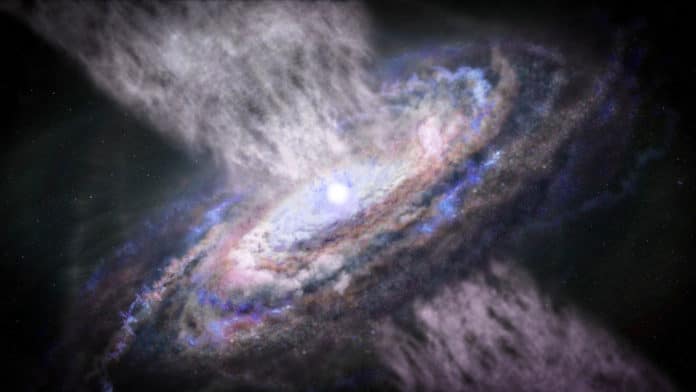Scientists- using data gathered by the Large Area Telescope onboard NASA’s Fermi Gamma-ray Space Telescope- for the first time, have detected gamma rays from UFOs in several nearby galaxies. This discovery was made possible by using a stacking technique combining signals too weak to observe independently.
UFOs stand for ultra-fast outflows, which are strong winds launched from very near supermassive black holes. These UFOs are believed to play a vital role in adjusting the growth of the black hole itself and its host galaxy.
Chris Karwin, a postdoctoral fellow in the College of Science’s Department of Physics and Astronomy and leader of the study, said, “Although these winds are challenging to detect, it is thought that they play a significant role in how a massive black hole and the host galaxy itself grow. Our gamma-ray observations show how supermassive black holes can transfer a large amount of energy to their host galaxy. These UFOs create shock waves, which act like pistons and accelerate charged particles, known as cosmic rays, to near the speed of light.”
Marco Ajello, an associate professor in Clemson College of Science’s Department of Physics and Astronomy who is co-leading the study, said, “While traveling through the galaxies, the winds gradually disable star formation. The effect on the galaxy is dramatic. The black hole at the center of the galaxy and the galaxy itself have a mechanism to grow together in mass — and this is the mechanism.”
Karwin said, “Because cosmic rays produce the gamma rays detected accelerated at the shock front. It attests to the onset of the wind-host interaction and that the UFOs can energize charged particles up to the transition region between galactic and extragalactic cosmic rays.”
According to scientists, the discovery could help us understand what happened in our own Milky Way galaxy.
Karwin said, “Today, our black hole, Sagittarius A*, is not active, but it’s possible it was active in the recent past, maybe up until a few hundred years ago. Our model supports the hypothesis that these Fermi bubbles may be remnants of past UFO-like activity from the supermassive black hole in the center of our galaxy.”
Ajello said, “future work includes studying galaxies that have had active UFO winds for 10s of millions of years that have already traveled to the outskirts of the galaxy.”
Journal Reference:
- M. Ajello et al. Gamma Rays from Fast Black-hole Winds. DOI: 10.3847/1538-4357/ac1bb2
